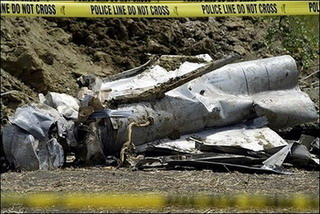
EXPERT REPORT ON MISSILE DROP IN GEORGIA LEAVES UNANSWERED QUESTIONS
Publication: Eurasia Daily Monitor Volume: 4 Issue: 160
By:

On August 12-14 in Georgia, an international group of experts investigated the circumstances of the August 6 Russian air incursion and missile drop on that country. Following the incident, Georgia called for an independent international investigation — independent meaning that the experts would volunteer their services and that the group would work outside the framework of organizations that are constrained by Russia’s veto, such as the United Nations and the Organization for Security and Cooperation in Europe (OSCE).
The group of experts on military aviation and air space control consisted of three Americans, two Lithuanians, two Swedes, and a Latvian. The Georgian government had requested some other countries — including Britain, France, Germany, and Finland, as well as European Union authorities — to participate in the group, but those countries and authorities apparently declined. Indeed French and German diplomats had recommended an investigation by the OSCE, well realizing that the organization is subject to Russia’s veto power. The lack of reception in London, Paris, and Berlin confirms that the erstwhile Group of Georgia’s Friends (the United States, Britain, France, Germany) has lost its meaning since admitting Russia as a full member and renaming itself as the UN Secretary-General’s Friends of Georgia.
The expert group released a short, apparently final report on August 14 after three days of work in Tbilisi, in the area of Gori (where the Russian missile was dropped), and at Georgia’s air force base. Based on radar information and witness testimonies, the report concludes that Georgia’s air space was violated on August 6 when “unidentified aircraft flew from Russian air space into Georgian air space and back again into Russian air space, three times,” totaling 23 minutes in Georgian air space. Each pass was conducted by a single plane, and on the third pass the intruding plane dropped the missile near Gori. Thus the report leaves open the possibility that more than one plane may have been involved in the three intrusions.
The report identifies the projectile as the Russian anti-radar missile Kh-58, but says that the investigative group was “unable to identify the aircraft type or origin.” It merely notes that Georgia’s air force does not operate aircraft able to fly the profile flown by the “unidentified” plane and does not possess aircraft equipped with or able to launch Kh-58 missiles.
The expert group “has not been able to verify statements concerning a man-portable missile [MANPAD] being fired at the unidentified aircraft.” This point alludes to Russian “peacekeeping” commander Major-General Marat Kulakhmetov’s August 7 public statement that South Ossetian forces had fired such a missile at the plane, believing it to be Georgian.
Following the August 6 incident, Georgia had identified the intruding aircraft as Su-24 or Su-25, ultimately concluding that it was a Su-24. Indeed, this type of Russian plane is known to be equipped for launching that type of anti-radar missile. It remains unclear for the moment why the report does not endorse that identification.
On the whole, the report seems to follow a minimalist approach (consistent perhaps with the group’s minimal size and the investigation’s quick completion). It stops short of pulling some important and seemingly obvious threads together. It could have noted, for example, the coincidence of the anti-radar missile being dropped near Gori, site of Georgia’s newly installed radar. Or, the coincidence of the intruding aircraft flying from North Ossetia, site of Russia’s Mozdok base, where Su-24s and Su-25s are based. It could also have noted that anti-aircraft missiles were previously spotted in the possession of South Ossetian forces, frustrating OSCE efforts to remove such weapons from circulation.
Thus, the report in its form released on August 14 misses the opportunity to raise those issues for international attention. If the expert group aimed for an immediate, tangible result of its work, a more developed version of the report could add the necessary background and context.
Apparently, Georgia’s radar information was deemed by the expert group as insufficient for identifying the violator aircraft’s “type and origin.” In that case, Georgia is entitled under international law to have the radar capability to identify intruding planes; particularly when these are getting into the habit of launching projectiles (this is the second case this year, after Kodori in March). Absent adequate radars in Georgia, Russia will continue enjoying a large margin of deniability, for further air incursions.
The expert group’s report confirms Georgia’s information that its air space was violated “from Russian air space.” To that extent, this report has a limited degree of usefulness to the goal, shared by Georgia and its allies, of discouraging the recurrence of such incidents. But the “air space” cannot be held accountable for repeated, egregious violations of international law.
(“Report of the International Group of Experts,” August 14; Civil Georgia, The Messenger, August 13-14)




